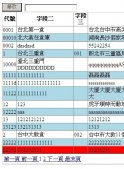一、資源文件
資源文件顧名思義就是存放資源的文件。資源文件在程序設(shè)計(jì)中有著自身獨(dú)特的優(yōu)勢(shì),他獨(dú)立于源程序,這樣資源文件就可以被多個(gè)程序使用。同時(shí)在程序設(shè)計(jì)的時(shí)候,有時(shí)出于安全或者其他方面因素的考慮,把重要東西存放在資源文件中,也可以達(dá)到保密、安全的效果。那么Visual C#所使用的資源文件中到底存放哪些東西呢?在用Visual C#創(chuàng)建資源文件大致可以存放三種類型的數(shù)據(jù)資源,分別是字節(jié)數(shù)組、各種對(duì)象和字符串。本文將結(jié)合一個(gè)程序例子來(lái)具體說(shuō)明用Visual C#是如何創(chuàng)建資源文件的。
二、創(chuàng)建資源文件所用的類
在.Net FrameWork SDK中的一個(gè)名字叫System.Resources名稱空間,在此名稱空間中為應(yīng)用程序提供了許多創(chuàng)建、存儲(chǔ)和使用資源文件的類和接口。其中有一個(gè)類叫ResourceWriter,Visual C#就是通過(guò)調(diào)用這個(gè)類來(lái)實(shí)現(xiàn)創(chuàng)建、存儲(chǔ)資源文件的。
三、創(chuàng)建資源文件的方法
首先要繼承一個(gè)ResourceWriter類,然后調(diào)用ResourceWriter類的一個(gè)方法Generate ( ),就可以產(chǎn)生一個(gè)資源文件了。具體語(yǔ)句如下:
ResourceWriter rw = new ResourceWriter ( "My.resources" ) ;
rw.Generate ( ) ;
此時(shí)在磁盤的中就會(huì)產(chǎn)生一個(gè)名稱為"My.resources"的資源文件,但此時(shí)的資源文件沒有任何內(nèi)容,下面我們就來(lái)看看如何往資源文件中添加資源。
四、往資源文件中添加資源的方法
在ResourceWriter類中提供了一個(gè)AddResource ( )方法,這個(gè)方法的作用就是往資源文件中添加資源的。在Visual C#中對(duì)不同的資源有著不同的加入方式。
(1).加入字節(jié)數(shù)組,語(yǔ)法格式為:
public void AddResource ( string , byte [ ] ) ;
注釋:其中string是在使用資源文件的時(shí)候,此字節(jié)數(shù)組在程序中的的唯一標(biāo)識(shí)符
(2).加入對(duì)象,語(yǔ)法格式為:
public void AddResource ( string , object );
注釋:其中string是在使用資源文件的時(shí)候,此對(duì)象在程序中的唯一標(biāo)識(shí)符。如:
復(fù)制代碼代碼如下:
Image image1 = Image.FromFile ("abc1.jpg") ;
Image image2 = Image.FromFile ( "abc2.jpg" ) ;
rw.AddResource ( "abc1" , image1 ) ;
rw.AddResource ( "abc2" , image2 ) ;
(3).加入字符串,具體語(yǔ)法如下:
public void AddResource ( string1 , string2) ;
注釋:其中string1是在使用資源文件的時(shí)候,此字符串在程序中的唯一標(biāo)識(shí)符在本文的程序中,是如此使用的:
rw.AddResource ( "MyStr" , "從資源文件中讀取字符串!" );
至此我們已經(jīng)創(chuàng)建了一個(gè)資源文件,并且在資源文件中加入了若干個(gè)資源,當(dāng)然在這之后,還應(yīng)該注意,保存此資源文件,并關(guān)閉資源文件,具體如下:
rw.Close ( ) ;
五、示例創(chuàng)建資源文件
在這里創(chuàng)建一個(gè)什么樣的工程好呢?有些朋友可能會(huì)用.net創(chuàng)建一個(gè)“控制臺(tái)應(yīng)用程序”,其實(shí)沒必要,直接用記事本創(chuàng)建一個(gè)CS文件就可以了,假如名稱為:CreatResources.cs。編譯命令:csc CreatResources.cs;運(yùn)行:CreatResources。這時(shí)會(huì)產(chǎn)生一個(gè)叫做My.resources的資源文件。先放到這里,等下再用。
復(fù)制代碼代碼如下:
using System ;
using System.Drawing ;
using System.Resources ;
class CreatResource
{
public static void Main ( )
{
ResourceWriter rw = new ResourceWriter ( "My.resources" ) ;
Image image1 = Image.FromFile ("abc1.jpg") ;
Image image2 = Image.FromFile ( "abc2.jpg" ) ;
rw.AddResource ( "abc1" , image1 ) ;
rw.AddResource ( "abc2" , image2 ) ;
Icon ic = new Icon("CDDRIVE.ICO");
rw.AddResource( "abc3",ic);
rw.AddResource( "abc4","這是從資源文件中讀出的字符");
rw.Generate ( ) ;
rw.Close ( ) ;
}
}
六、將生成的資源文件添加測(cè)試工程中的方法
創(chuàng)建一個(gè)“Windows應(yīng)用程序”測(cè)試工程,將My.resources資源文件添加到該工程中,步驟如下:
1,在資源管理器里選中文件
2,按住鼠標(biāo)左鍵,拖到工程文件上,松開鼠標(biāo)左鍵。
3,在拖放的文件上點(diǎn)鼠標(biāo)右鍵,選“屬性”
4,在生成操作里選擇“嵌入的資源”。
七、如何在程序中管理資源文件中的資源
在.Net FrameWork SDK這提供了一個(gè)關(guān)于資源文件創(chuàng)建和使用的名稱空間--System.Resources。在這個(gè)名稱空間中有一個(gè)Class為ResourceManager,這個(gè)Class的主要作用就是管理并使用資源文件。Visual C#是通過(guò)這個(gè)類來(lái)管理并使用嵌入程序中的資源文件中的資源。下列代碼就是定義一個(gè)ResourceManager類來(lái)管理嵌入程序資源文件中的資源:
ResourceManager rm = new ResourceManager ( " Res.My " , Assembly.GetExecutingAssembly ( ) ) ;
注意:ResourceManager rm = new ResourceManager ( " Res.My " , Assembly.GetExecutingAssembly ( ) ) ;語(yǔ)句中,構(gòu)造函數(shù)的第一個(gè)參數(shù)Res.My 由兩部分構(gòu)成,Res表示測(cè)試工程的命名空間,My表示資源文件名My.resources的根名稱,即點(diǎn)號(hào)有前部分My。
八、如何在程序中使用資源文件中的資源
使用了AddResource ( )方法來(lái)加入資源,他的語(yǔ)法中的第一個(gè)參數(shù)是用戶可以定義的字符串,這個(gè)字符串就是資源在資源文件的唯一標(biāo)識(shí),在程序設(shè)計(jì)中,就是通過(guò)這個(gè)唯一標(biāo)識(shí)符來(lái)使用某個(gè)資源的。那么如何在程序中通過(guò)這個(gè)標(biāo)識(shí)符來(lái)得到所需資源?這就要使用到ResourceManager類中的GetObject()和GetString()方法。這二個(gè)方法作用是獲得指定的資源。下面是這二個(gè)方法的語(yǔ)法:
object GetSting(String)
object GetObject(String)
其中的"String"就是資源在資源文件中的那個(gè)唯一標(biāo)識(shí)符。細(xì)心的讀者可能已經(jīng)注意到,這二個(gè)方法的返回值都是一個(gè)Object類型的變量,也就是一個(gè)參考類型的變量,而在程序中的字符串或者圖象等,是一個(gè)實(shí)值類型變量。這就需要進(jìn)行轉(zhuǎn)換,而這種轉(zhuǎn)換就是上面所說(shuō)的裝箱和出箱。下列代碼是從資源文件中提取字符串、圖象和圖標(biāo)資源:
提取字符串資源:
String s = ( ( String ) rm.GetString ( "MyStr" ) ) ;
提取圖標(biāo)資源:
Icon icoDemo = ( ( Icon ) rm.GetObject ( "demo.ico" ) ) ;
提取圖象資源:
Image a = ( ( Image ) ( rm.GetObject ( "ok-off.png" ) ) ) ;
九、測(cè)試工程源代碼
復(fù)制代碼代碼如下:
using System;
using System.Drawing;
using System.Collections;
using System.ComponentModel;
using System.Windows.Forms;
using System.Data;
// 加入以下兩個(gè)命名空間。
using System.Resources;
using System.Reflection;
namespace Res
{
///
/// Form1 的摘要說(shuō)明。
///
public class Form1 : System.Windows.Forms.Form
{
private System.Windows.Forms.PictureBox pictureBox1;
private System.Windows.Forms.Button button1;
private System.Windows.Forms.Button button2;
private System.Windows.Forms.Button button3;
private System.Windows.Forms.Label label1;
private System.Windows.Forms.Button button4;
///
/// 必需的設(shè)計(jì)器變量。
///
private System.ComponentModel.Container components = null;
public Form1()
{
//
// Windows 窗體設(shè)計(jì)器支持所必需的
//
InitializeComponent();
//
// TODO: 在 InitializeComponent 調(diào)用后添加任何構(gòu)造函數(shù)代碼
//
}
///
/// 清理所有正在使用的資源。
///
protected override void Dispose( bool disposing )
{
if( disposing )
{
if (components != null)
{
components.Dispose();
}
}
base.Dispose( disposing );
}
#region Windows 窗體設(shè)計(jì)器生成的代碼
///
/// 設(shè)計(jì)器支持所需的方法 - 不要使用代碼編輯器修改
/// 此方法的內(nèi)容。
///
private void InitializeComponent()
{
this.pictureBox1 = new System.Windows.Forms.PictureBox();
this.button1 = new System.Windows.Forms.Button();
this.button2 = new System.Windows.Forms.Button();
this.button3 = new System.Windows.Forms.Button();
this.label1 = new System.Windows.Forms.Label();
this.button4 = new System.Windows.Forms.Button();
this.SuspendLayout();
//
// pictureBox1
//
this.pictureBox1.BorderStyle = System.Windows.Forms.BorderStyle.FixedSingle;
this.pictureBox1.Location = new System.Drawing.Point(8, 8);
this.pictureBox1.Name = "pictureBox1";
this.pictureBox1.Size = new System.Drawing.Size(256, 240);
this.pictureBox1.SizeMode = System.Windows.Forms.PictureBoxSizeMode.StretchImage;
this.pictureBox1.TabIndex = 0;
this.pictureBox1.TabStop = false;
//
// button1
//
this.button1.Location = new System.Drawing.Point(280, 8);
this.button1.Name = "button1";
this.button1.Size = new System.Drawing.Size(88, 24);
this.button1.TabIndex = 1;
this.button1.Text = "圖像1";
this.button1.Click += new System.EventHandler(this.button1_Click);
//
// button2
//
this.button2.Location = new System.Drawing.Point(280, 48);
this.button2.Name = "button2";
this.button2.Size = new System.Drawing.Size(88, 24);
this.button2.TabIndex = 2;
this.button2.Text = "圖像2";
this.button2.Click += new System.EventHandler(this.button2_Click);
//
// button3
//
this.button3.Location = new System.Drawing.Point(280, 128);
this.button3.Name = "button3";
this.button3.Size = new System.Drawing.Size(88, 24);
this.button3.TabIndex = 2;
this.button3.Text = "文字";
this.button3.Click += new System.EventHandler(this.button3_Click);
//
// label1
//
this.label1.Location = new System.Drawing.Point(8, 264);
this.label1.Name = "label1";
this.label1.Size = new System.Drawing.Size(360, 16);
this.label1.TabIndex = 4;
this.label1.Text = "label1";
//
// button4
//
this.button4.Location = new System.Drawing.Point(280, 88);
this.button4.Name = "button4";
this.button4.Size = new System.Drawing.Size(88, 24);
this.button4.TabIndex = 2;
this.button4.Text = "圖標(biāo)";
this.button4.Click += new System.EventHandler(this.button4_Click);
//
// Form1
//
this.AutoScaleBaseSize = new System.Drawing.Size(6, 14);
this.ClientSize = new System.Drawing.Size(376, 285);
this.Controls.Add(this.label1);
this.Controls.Add(this.button2);
this.Controls.Add(this.button1);
this.Controls.Add(this.pictureBox1);
this.Controls.Add(this.button3);
this.Controls.Add(this.button4);
this.Name = "Form1";
this.Text = "Form1";
this.ResumeLayout(false);
}
#endregion
///
/// 應(yīng)用程序的主入口點(diǎn)。
///
[STAThread]
static void Main()
{
Application.Run(new Form1());
}
private void button1_Click(object sender, System.EventArgs e)
{
System.Resources.ResourceManager rm = new ResourceManager("Res.My",Assembly.GetExecutingAssembly());
this.pictureBox1.Image = (Bitmap)rm.GetObject("abc1");
}
private void button2_Click(object sender, System.EventArgs e)
{
System.Resources.ResourceManager rm = new ResourceManager("Res.My",Assembly.GetExecutingAssembly());
this.pictureBox1.Image = (Bitmap)rm.GetObject("abc2");
}
private void button4_Click(object sender, System.EventArgs e)
{
System.Resources.ResourceManager rm = new ResourceManager("Res.My",Assembly.GetExecutingAssembly());
this.Icon = (Icon)rm.GetObject("abc3");
}
private void button3_Click(object sender, System.EventArgs e)
{
System.Resources.ResourceManager rm = new ResourceManager("Res.My",Assembly.GetExecutingAssembly());
this.label1.Text = rm.GetString("abc4");
}
}
}












